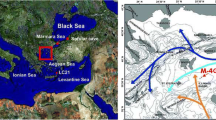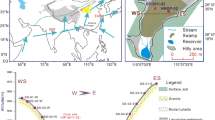Abstract
High-resolution geochemical, isotope and elemental data from core PC23A in the northern margin of the Aleutian Basin (Bering Sea) were used to reconstruct distinct paleoceanographic features of the last deglaciation (pre-Boreal[PB], Bølling-Allerød[BA], Younger Dryas[YD]). The PB and BA intervals are characterized by increased siliceous (diatom) and calcareous (coccolithophores and foraminifers) productivity represented by high biogenic opal and CaCO3 contents, respectively. The enhanced productivity can plausibly be attributed to an elevated sea-surface nutrient supply from increased melt-water input and enhanced Alaskan Stream injection under warm, restricted sea-ice conditions. High Corg/N ratios and low δ13C values of sediment organic matter during the PB and BA intervals reflect the contribution of terrestrial organic matters. The PB and BA intervals were also identified by laminated sediment layers of core PC23A, characterized by high Mo/Al and Cd/Al ratios, indicating that the bottom water condition remained anoxic. High δ15N values during the same period were attributed mainly to the increased nutrient utilization and subsequent denitrification of seawater nitrate. Part of high δ15N values may also be due to incorporation of inorganic nitrogen in the clay minerals. It is worthy of note that high total organic carbon (TOC) deposition occurred approximately 3,000 years before onset of the last deglaciation. Simultaneous high Corg/N ratios and low δ13C values clearly suggest that the high TOC content should be related to terrestrial organic carbon input. Low δ15N values during the high TOC interval also confirm the contribution of terrigenous organic matter. Although abundant calcareous phytoplankton production under cold, nutrient-poor conditions represented by Baex data was reported for high TOC deposition preceding the last deglaciation in an earlier study of the Okhotsk Sea, the main reason for the enhanced TOC deposition in the Bering Sea is an increased terrigenous input from the submerged continental shelves (Beringia) with a sea-level rise; this is further supported by Al enrichment of bulk sediments during the high TOC deposition.
Similar content being viewed by others
References
Bahk JJ, Han SJ, Khim BK (2004) Variations of terrigenous sediment supply to the southern slope of the Ulleung Basin, the East/Japan Sea since the Last Glacial Maximum. Geosci J 8:381–390
Behl RJ, Kennett JP (1996) Brief interstadial events in the Santa Barbara Basin, NE Pacific, during the past 60 kyr. Nature 379:243–246
Brunelle BG, Sigman DM, Cook MS, Keigwin LD, Haug GH, Plessen B, Schettler G, Jaccard SL (2007) Evidence from diatombound nitrogen isotopes for subarctic Pacific stratification during the last ice age and a link to North Pacific denitrification changes. Paleoceanography 22:PA1215. doi:10.1029/2005PA001205
Caissie BE, Brigham-Grette J, Lawrence KT, Herbert TD, Cook MS (2010) Last Glacial Maximum to Holocene sea surface conditions at Umnak Plateau, Bering Sea, as inferred from diatom, alkenone, and stable isotope records. Paleoceanography 25:PA1206. doi:10.1029/2008PA001671
Chekhovskaya MP, Basov IA, Matul AG, Khusid TA, Gorbarenko SA (2008) Planktonic foraminifers in the southern Bering Sea: changes in composition and productivity during the late Pleistocene-Holocene. Stratigr Geol Corr 16:328–342
Cook MS, Keigwin LD, Sancetta CA (2005) The deglacial history of surface and intermediate water of the Bering Sea. Deep-Sea Res II 52:2163–2173
Crusius J, Calvert SE, Pedersen TF, Saga D (1996) Rhenium and molybdenum enrichments in sediments as indicators of oxic, suboxic and anoxic conditions of deposition. Earth Planet Sci Lett 145:65–78
Crusius J, Pedersen TF, Kienast S, Keigwin L, Labeyrie L (2004) Influence of northwest Pacific productivity on North Pacific Intermediate Water oxygen concentrations during the Bølling-Allerød interval (14.7–12.9 ka). Geology 32:633–636
DeMaster DJ (1981) The supply and accumulation of silica in the marine-environment. Geochim Cosmochim Acta 45:1715–1732
Feely RA, Sabine CL, Lee K, Millero FJ, Lamb MF, Greeley D, Bullister JL, Key RM, Peng T-H, Kozyr A, Ono T, Wong CS (2002) In situ calcium carbonate dissolution in the Pacific Ocean. Global Biogeochem Cycles 16:1144. doi:10.1029/2002GB001866
Gorbarenko SA, Basov IA, Chekhovskaya MP, Southon J, Khusid TA, Artemova AV (2005) Orbital and millennium scale environmental changes in the southern Bering Sea during the last glacial-Holocene: geochemical and paleontological evidence. Deep-Sea Res II 52:2174–2185
Gorbarenko SA, Wang P, Wang R, Cheng X (2010) Orbital and suborbital environmental changes in the southern Bering sea during the last 50 kyr. Palaeogeogr Palaeoclimatol Palaeoecol 286:97–106
Hu A, Meehl GA, Han W (2007) Role of the Bering Strait in the thermohaline circulation and abrupt climate change. Geophys Res Lett 34:L05704. doi:10.1029/2006GL028906
Inagaki M, Yamamoto M, Igarashi Y, Ikehara K (2009) Biomarker records from core GH02-1030 off Tokachi in the northwestern Pacific over the last 23,000 years: environmental changes during the last deglaciation. J Oceanogr 65:847–858
Ishizaki Y, Ohkushi K, Ito T, Kawahata H (2009) Abrupt changes of intermediate-water oxygen in the northwestern Pacific during the last 27 kyr. Geo Mar Lett 29:125–131
Itaki T, Komatsu N, Motoyama I (2007) Orbital- and millennialscale changes of radiolarian assemblages during the last 220 kyrs in the Japan Sea. Palaeogeogr Palaeoclimatol Palaeoecol 247:115–130
Itaki T, Uchida M, Kim S, Shin HS, Tada R, Khim BK (2009) Late Pleistocene stratigraphy and paleoceanographic implications in northern Bering Sea slope sediments: evidence from the radiolarian species Cycladophora davisiana. J Quat Sci 24: 856–865
Jaccard SL, Haug GH, Sigman DM, Pedersen TF, Thierstein HR, Röhl U (2005) Glacial/interglacial changes in subarctic North Pacific stratification. Science 308:1003–1006
Katsuki K, Takahashi K (2005) Diatoms as paleoenvironmental proxies for seasonal productivity, sea-ice and surface circulation in the Bering Sea during the late Quaternary. Deep-Sea Res II 52:2110–2130
Keigwin LD, Jones GA (1990) Deglacial climatic oscillation in the Gulf of California. Paleoceanography 5:1009–1023
Keigwin LD, Jones GA, Froelich PN (1992) A 15,000 year paleoenvironmental record from Meiji Seamount, far northwestern Pacific. Earth Planet Sci Lett 111:425–440
Kiefer T, Sarnthein M, Erlenkeuser H, Grootes PM, Robert AP (2001) North Pacific response to millennial-scale changes in ocean circulation over the last 60 kyr. Paleoceanography 16:179–189
Morley JJ, Robinson SW (1986) Improved method for correlating late Pleistocene/Holocene records from the Bering Sea: application of a biosiliceous/geochemical stratigraphy. Deep-Sea Res I 33:1203–1211
Mortlock RA, Froelich PN (1989) A simple method for the rapid determination of biogenic opal in marine sediments. Deep-Sea Res I 36:1415–1426
Narita H, Sato M, Tsunogai S, Murayama M, Ikehara M, Nakatsuka T, Wakatsuchi M, Harada N, Ujiie Y (2002) Biogenic opal indicating less productive northwestern North Pacific during the glacial ages. Geophys Res Lett 29:1732. doi:10.1029/2001GL014320
Niebauer HJ, Bond NA, Yakunin LP, Plotnikov VV (1999) An update on the climatology and sea ice of the Bering Sea. In: Loughlin TR, Ohtani K (eds) Dynamics of the Bering Sea. University of Alaska Sea Grant, Fairbanks, AK, pp 22–59
Ohkushi K, Itaki T, Nemoto N (2003) Last glacial-Holocene change in intermediate water ventilation in the North Pacific. Quat Sci Rev 22:1477–1484
Okada M, Takagi M, Narita H, Takahashi K (2005) Chronostratigraphy of sediment cores from the Bering Sea and the subarctic Pacific based on paleomagnetic and oxygen isotopic analyses. Deep-Sea Res II 52:2092–2109
Okazaki Y, Takahashi K, Asahi A, Katsuki K, Hori J, Yasuda H, Sagawa Y, Tokuyama H (2005) Productivity changes in the Bering Sea during the late Quaternary. Deep-Sea Res II 52:2150–2162
Sancetta CA, Heusser L, Labeyrie L, Naidu AS, Robinson SW (1985) Wisconsin-Holocene paleoenvironment of the Bering Sea: evidence from diatoms, pollen, oxygen isotopes and clay minerals. Mar Geol 62:55–68
Sato MM, Narita H, Tsunogai S (2002) Barium increasing prior to opal during the last termination of glacial ages in the Okhotsk Sea sediments. J Oceanogr 58:461–467
Seki O, Kawamura K, Nakatsuka T, Ohnishi K, Ikehara M, Wakatsuchi M (2003) Sediment core profiles of long-chain n-alkanes in the Sea of Okhotsk: enhanced transport of terrestrial organic matter from the last deglaciation to the early Holocene. Geophys Res Lett 30:1001. doi:10.1029/2001GL014464
Sigman DM, Altabet MA, Francois R, McCorkle DC, Fischer G (1999) The 15N of nitrate in the Southern Ocean: consumption of nitrate in surface waters. Global Biogeochem Cycles 13: 1149–1166
Stuiver M, Reimer PJ, Bard E, Beck JW, Burr GS, Hughen KA, Kromer B, McCormac FG, Plicht JVD, Spurk M (1998) INTCAL98 Radiocarbon age calibration 24,000-0 cal BP. Radiocarbon 40:1041–1083
Takahashi K (2005) The Bering Sea and paleoceanography. Deep-Sea Res II 52:2080–2091
Tanaka S, Takahashi K (2005) Late Quaternary paleoceanographic changes in the Bering Sea and the western subarctic Pacific based on radiolarian assemblage. Deep-Sea Res II 52:2131–2149
Ternois Y, Kawamura K, Keigwin L, Ohkouchi N, Nakatsuka T (2001) A biomarker approach for assessing marine and terrigenous inputs to the sediments of Sea of Okhotsk for the last 27,000 years. Geochim Cosmochim Acta 65:791–802
Uchida M, Ohkushi K, Kimoto K, Inagaki F, Ishimura T, Tsunogai U, TuZino T, Shibata Y (2009) Radiocarbon-based carbon source quantification of anomalous isotopic foraminifera in glacial sediments in the western North Pacific. Geochem Geophys Geosys 9:Q04N14. doi:10.1029/2006GC001558
Uchida M, Shibata Y, Yoneda M, Kobayashi T, Morita, M (2004) Technical progress of microscale radiocarbon analysis. Nuclear Instru Material Methods Phys Res-B 223–224:313–317
van Geen A, Zheng Y, Bernhard JM, Cannariato KG, Carriquiry J, Dean WE, Eakins BW, Ortiz JD, Pike J (2003) On the preservation of laminated sediments along the western margin of North America. Paleoceanography 18:1098. doi:10.1029/2003PA000911
Warner MJ, Roden GI (1995) Chlorofluorocarbon evidence for recent ventilation of the deep Bering Sea. Nature 373:409–412
Zheng Y, van Geen A, Anderson RF, Gardner JV, Dean WE (2000) Intensification of the northeast Pacific oxygen minimum zone during the Bølling-Allerød warm period. Paleoceanography 15:528–536
Author information
Authors and Affiliations
Corresponding author
Rights and permissions
About this article
Cite this article
Khim, BK., Kim, S., Uchida, M. et al. High organic carbon deposition in the northern margin of the Aleutian Basin (Bering Sea) before the last deglaciation. Ocean Sci. J. 45, 203–211 (2010). https://doi.org/10.1007/s12601-010-0019-y
Received:
Revised:
Accepted:
Published:
Issue Date:
DOI: https://doi.org/10.1007/s12601-010-0019-y




